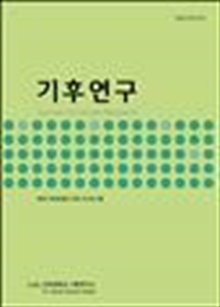간행물
기후연구 KCI 등재 Journal of Climate Research

- 발행기관 건국대학교 기후연구소
- 자료유형 학술지
- 간기 계간
- ISSN 1975-6151 (Print)2288-8772 (Online)
- 수록기간 2006 ~ 2021
- 주제분류 사회과학 > 지리학 사회과학 분류의 다른 간행물
- 십진분류KDC 453DDC 551
권호리스트/논문검색
제15권 제1호 (2020년 3월) 3건
1.
2020.03
서비스 종료(열람 제한)
In this study, the spatio-temporal patterns of summertime thermal environments in the two subtropical cities (Jeju and Seogwipo) of Jeju Island, Korea are examined. Long-term average data from Jeju and Seogwipo show that higher human sensible temperature (HST) than air temperature (T) due to the high humidity effects associated with warm sea surface temperature around Jeju Island is most distinct during mid-summer period (late July-early August). Comparatively, their trend analyses reveal that summertime intra-seasonal changes with more increasing HST than T are most obviously observed in late summer (late September-early October) and regionally in Seogwipo. According to the hourly temperature-humidity data measured at approximately 30 HOBO temperature-humidity sensors deployed in the two subtropical cities during 2019 summer, the greater HST than T during mid-summer period maximizes up to 6.2°C and 7.0°C across the urban areas of Jeju and Seogwipo, respectively in early afternoon, leading to consecutive inter-daily heat wave events. The examination of their spatial patterns demonstrates that bioclimatic heat waves in these two subtropical cities are affected primarily by the urban heat island phenomenon. However, it should not be overlooked that local moisture advection from the warm ocean adjacent to the subtropical cities can modify the stronger heat wave pattern toward urban cores. It is also notable that according to comparisons of local HST and T distributions between impervious urban cores and neighboring urban parks, not only the size of green space but also other ecological properties including species of vegetation may be crucial factors to the mitigation of hot thermal environments in subtropical cities during summers.
2.
2020.03
서비스 종료(열람 제한)
An application of an integrated climate extreme index (CEI) is presented, that quantifies observed climate change of South Korea by various five indicators. Based on an annual basis surface observation station data, climate extreme indicators that measure the fraction of the stations in South Korea are analyzed. Results for the annual CEI indicate that the area experiencing much above-normal maximum and minimum temperatures in recent years has been increased. The extremes in much greater-than-normal number of days with or without precipitation has a large interannual variability similar with much above and below normal standardized precipitation index. Results from above-normal proportion of heavy daily precipitation show a more pronounced increasing feature from 1990’s to the early 2010’s. Five indicators in CEI had distinct contrasting features which indicates that CEI can be a useful tool in providing the information on the percentage of the climate in South Korea that experienced various kinds of extreme conditions during any given year or period.
3.
2020.03
서비스 종료(열람 제한)
Global warming due to the increase of greenhouse gases may significantly affect various aspects of the Earth’s environment and human life. In particular, the impacts of climate change on agriculture would be severe, leading to damages to crop yields. This paper examines the experimental prediction of rice yield in China using DNN (deep neural network) and climate model data for the period between 1979 and 2009. The DNN model built through the process of hyperparameter optimization can mitigate an overfitting problem and cope with outlier cases. Our model showed approximately 38.7% improved accuracy than the MLR (multiple linear regression) model, in terms of correlation coefficient with the yield statistics. We found that the diurnal temperature range and potential evapotranspiration were the critical factors for rice yield prediction. Our DNN model was also robust to extreme conditions such as drought in 2006 and 2007 in China, which showed its applicability to the future simulation of crop yields under climate change.

